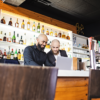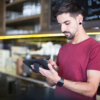Crafting a restaurant marketing plan is essential to stay afloat in the thriving industry. However, the journey to success can be overwhelming due to the numerous factors to consider when developing your strategy.
Whether you’re focusing on details like your menu or going for an overall approach to market your restaurant, the key is to have a well-thought-out strategic plan.
In this blog post, we’ll dive into the importance of restaurant marketing and provide valuable tips to kickstart your strategy. We’ll also unpack crucial factors and ideas for you to consider when captivating and expanding your customer base.
Let’s shape up your marketing strategy and kick things into gear!
What is restaurant marketing?
Restaurant marketing is the strategic promotion of a dining establishment to attract and retain customers. The strategy can vary widely based on the unique characteristics of your target audience.
Understanding and catering to the preferences and behaviors of your specific audience is essential when crafting effective marketing strategies. For instance, if your target audience is tech-savvy and active on social media, focusing on online promotions and engaging content would be more effective than traditional advertising methods.
To help you start launching your restaurant’s marketing efforts, we have compiled various ideas that can be customized to suit different target audiences.
16 Restaurant Marketing Ideas for 2024
1. Cultivate your brand image and customer profile
Cultivating a strong brand image and customer profile are vital strategies. A brand’s identity encompasses elements such as logos, colors, messaging, and core values that serve as the foundation for a recognizable presence.
In addition, understanding your customer profile, often referred to as a buyer persona, involves the process of creating a detailed description of someone who represents your target audience. This persona is fictional but based on deep research of your existing audience. The insight gained from your buyer persona enables tailored marketing efforts that resonate with your audience.
Lastly, establishing a central hub for your brand is crucial, and a key element of this is maintaining an updated website. Your website not only communicates your brand identity and credibility but also serves as a platform for both current and future customers. It provides a seamless way for consumers to stay connected with your restaurant.
2. Engage on social media
Did you know there are 4.76 billion active users on social media? It’s time to get your restaurant noticed by using social media! Leveraging social media platforms for marketing purposes not only increases visibility but also fosters customer engagement and competitiveness in the market.
While numerous platforms are beneficial for restaurant marketing, three major players stand out: Facebook, Instagram, and TikTok.
Each platform offers distinct features and ideal posting types but overall offers exceptional customer engagement. Choosing the social media platforms you want to be active on really depends on the kind of social media marketing you’re aiming for.
For instance, if you want to create fun and trending videos of your menu, aesthetics, and other specials, TikTok is your go-to platform. TikTok stands out because of its strength as an entertainment hub; it’s appealing and easy to watch because of the algorithm it uses for its viewers.
Start tick tockin’ your restaurant to the top of the For You Page!
3. Partner with an organization and/or charity
Partnering with an organization or charity is a great way to forge a meaningful connection with your community. Consider dedicating a specific day where a portion of your sales contributes to the cause of the chosen group. Additionally, you can enhance your community engagement by initiatives such as donating meals to local organizations in need.
This initiative not only showcases your restaurant’s commitment to supporting the community but also reflects on your restaurant’s values and dedication to making a positive impact. It contributes to increasing brand awareness and involvement within the community.
By aligning your business with a good cause, you attract patrons who support that cause, thereby enhancing your connection with the community and customer base.
4. Host a food challenge
Does your restaurant offer something on the menu that sets you apart from the competition? Consider providing your customers with a food challenge. This intrigues guests to come in to take part and bring their friends for support.
A food challenge allows your guests to feel special when all the attention is on them. This also gives your restaurant a great opportunity to be the place where everybody wants to go for fun.
Most challenges include an outrageous amount of food that needs to be eaten in a certain amount of time. Challenge winners then receive prizes such as a free meal, a t-shirt, and a small amount of fame.
5. Collab with local restaurants
Put competition aside and invite a fellow chef from a neighboring restaurant to yours for a collaboration dinner.
Both restaurants can create a special lineup of cocktails and food that equally represent both of their styles. A collaboration dinner helps build your business as well as expand your customer base.
If you have a bar, get your restaurant involved in a pub crawl. This is a time where large groups of people travel to different bars and restaurants throughout the day for a good time. This is an opportunity to create a fun drink special that captures everyone’s attention.
Supporting local restaurants and chefs boosts community spirit and encourages integration.
6. Market your restaurant location
Location and accessibility to your restaurant are just as important as the food and service. There are lots of important factors that come into play when customers are choosing a restaurant. You want your restaurant in a location that gets lots of foot traffic, has easy visibility, and is approachable to all. To make accessibility a seamless experience, consider providing clear directions on your website, especially if your location is challenging to find.
Additionally, you can highlight the unique features of your business, such as a cozy coffee shop for remote work, a sunny patio for outdoor enjoyment, or a weekly trivia night for entertainment options. This makes your restaurant not just a dining spot but a destination for a variety of activities.
Having a prime location spot for your restaurant can lead to a lot of fun opportunities. It gives you a chance to get creative with your surroundings.
If you have space for a large mural on the side of your building, this can draw people in to take photos and tag your restaurant. Have an outdoor chalkboard sign that’s fun and grabs people’s attention, the possibilities are endless.
7. Get involved with community events
To keep your restaurant at the forefront of people’s minds, you want to get them into your establishment as much as possible. It needs to be inviting to the community and a place where your customers create great memories. This can serve as a chance to host special events that draw in more people than usual.
One idea that you could try out is inviting local bands to come to perform at your restaurant. It gets people together for a fun shareable experience with great food and entertaining music.
You could also support local sports teams or leagues by sponsoring them. This could be done by offering discounts to team members or hosting game-day events at your restaurant.
8. Sell brand merchandise and gift cards
Looking to capitalize on a double win? Consider offering branded merchandise and gift cards. Beyond the immediate profit from these sales, you’re also strategically reaching potential customers. For instance, selling items like hats or water bottles with your logo turns customers into walking advertisements when they use or wear them.
Additionally, selling gift cards can lead to more revenue for your restaurant. Nearly 61% of consumers spend more than a gift card’s value when redeeming, for an average of $31.75 more than the card’s value.
By offering branded merchandise and gift cards, you’re not just selling products; you’re investing in a powerful restaurant marketing strategy that boosts your bottom line and expands your customer base.
9. Establish relationships with food influencers
With the rise of food influencers, foodies, and social media – this is the perfect time to get in the loop. An easy way to get your restaurant noticed is to partner with a food influencer.
Food influencers are social media content creators, industry experts, and celebrity chefs. They have the power to reach thousands on social media. Platforms such as Instagram, Facebook, and YouTube are where you’re most likely to find them.
Invite one to come to your restaurant for a free meal in return for an honest review and post-worthy content. Instagram is the gold standard for food influencers. They’ll post photos of the most appetizing food and cocktails your restaurant has to offer.
View this post on Instagram
Restaurants of all sizes can benefit from a food influencer, but the niche may be different for all. Take that into consideration when exploring what food influencer to partner with.
User-generated content from food influencers drives higher engagement with your customers. Their photos are trendy, and you can repost them on your social media to thank them.
10. Build buzz in your local magazine/newspaper
Let’s get back to the basics of advertising but with a fresh perspective. Whether you’re launching your first restaurant or expanding to a new location, reaching out to your local newspapers and magazines is a valuable strategy to generate excitement and anticipation for your establishment.
You can invite editors to come and join you for a free meal in exchange to be featured in their writing. This will give your restaurant a chance to showcase its best features. Ask the editor to write about their experience and share photos of their favorite dishes.
Your restaurant can reach a wide range of consumers with these now being both in print and digital. Getting featured will raise awareness for your restaurant. It’s also great content for you to share on your social media and website.
11. Word of mouth is your best friend
Let’s get back to the basics of advertising but with a fresh perspective. Whether you’re launching your first restaurant or expanding to a new location, reaching out to your local newspapers and magazines is a valuable strategy to generate excitement and anticipation for your establishment.
You can invite editors to come and join you for a free meal in exchange to be featured in their writing. This will give your restaurant a chance to showcase its best features. Ask the editor to write about their experience and share photos of their favorite dishes.
Your restaurant can reach a wide range of consumers with these now being both in print and digital. Getting featured will raise awareness for your restaurant. It’s also great content for you to share on your social media and website.
12. Use email marketing
Email marketing is a highly effective tactic for restaurants. It provides a direct line of communication with customers, allowing restaurants to keep their audience informed about promotions, new menu items, and special events.
With the right email marketing tools, you can gain insight into how emails are performing with analytics and content insight. As well as the ability to segment and target messaging for a more personalized approach.
If you’re lucky, you might even choose a platform that offers design templates to give you inspiration, like CAKE’s email marketing. It features a variety of custom-designed responsive templates to streamline the creative process.
Moreover, enticing visuals and engaging content in emails can stimulate cravings and drive repeat business. Email marketing is a versatile and effective tool for restaurants to connect with their audience and drive business.
13. Leverage a restaurant loyalty program
Loyal customers are what keeps your business running. They need to be earned, and that comes from your guest’s experience.
A restaurant loyalty program can incentivize your customers to come back, earn points, and spend rewards. You can encourage your guests to check in on Yelp each time they dine and collect reward points. Over time these programs can learn your customers’ needs and allow for personalized recommendations.
Loyalty also begins within the restaurant. Your staff needs to be personable and build relationships with your guests. Remembering names, familiar orders, and maintaining a positive attitude plays a pivotal role in cultivating loyal customers.
Nearly 60% of diners said a positive experience will cause them to dine at the restaurant more frequently. Again, the customer experience is everything.
14. Get set up on Google My Business
The term “food near me” had a search volume of 14.48 million on Google in 2023. This highlights its importance and the fact that people prioritize finding the right places to eat. Google provides a valuable tool for helping people discover and choose dining establishments.
To optimize your online presence and ensure that your restaurant stands out in search engine results, creating a free Google My Business (GMB) account is a great strategy. With local listings being more targeted in search engine optimization (SEO), having a GMB listing is crucial if you want your restaurant to appear at the top of search results.
Your GMB listing can be a one-stop shop for your customers. If they’re looking to order online, check out your hours, or make an online reservation, they can do so on your GMB. When you have an online reservation system, you can integrate that with your GMB profile. With a waitlist management system like ours, Guest Manager, it’s seamless and easy.
Capture curious customers when you market your business online with GMB. This increases your business’s visibility and drives customer engagement.
15. Promote your online ordering
Consumers crave convenience, and restaurants are no exception. Your customers want all food options readily available right at their fingertips.
There are many ways to promote your restaurant’s online ordering tool. For example, sharing your restaurant’s ordering website link on social media and through email marketing.
Online ordering is growing at a rapid 300% and is only expected to grow. To make it easily accessible for your customers to order from you, consider making a banner or call to action clearly displayed on your website that navigates to your ordering site. Another marketing idea is to place an individual quick-response (QR) code outside your storefront that also leads to your restaurant’s website for ordering takeout on the go.
Having an in-house online ordering system can help you save on commission fees and keep more profits back over third-party delivery apps, but additionally, you can partner with businesses such as DoorDash, Uber Eats, GrubHub, and more to get your restaurant visible on those platforms where your diners may be. Offering in-house delivery and promotions to save money on third-party delivery fees is a great way to capture customers and build loyalty.
16. Expand your reach with delivery services
Integrating delivery services into your restaurant’s marketing strategy not only broadens your reach but also boosts profits simultaneously, not to mention its continuous rapid growth.
Online food delivery in the United States boasted an estimated $218 billion in revenues in 2022, with over $76 billion attributed to the meal delivery segment. Projections indicate continued growth, with the market expected to expand further by 2027.
Incorporating delivery aligns your restaurant with current market trends, showcasing adaptability and responsiveness. In essence, strategic use of delivery services opens avenues for reaching new customers, gathering insights, and strengthening your overall marketing approach.
Master the Practice of Restaurant Marketing
This restaurant marketing guide emphasizes the importance of a multifaceted approach to drive growth, profitability, and customer loyalty. Key tactics include using social media, participating in local events, utilizing online delivery services, and communicating with customers online through your website & reviews. Implementing these strategies collectively contributes to a thriving restaurant, attracting new customers, encouraging repeat business, and fostering lasting customer loyalty.





